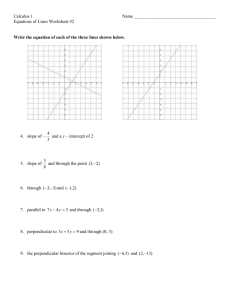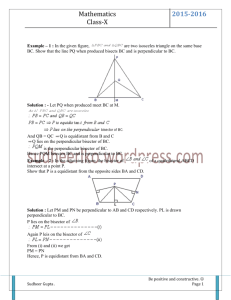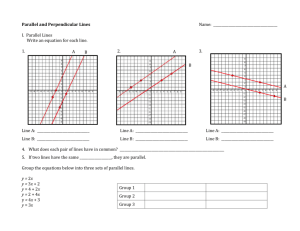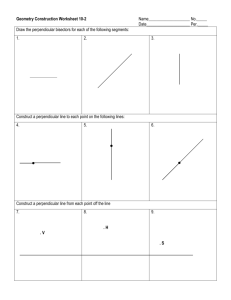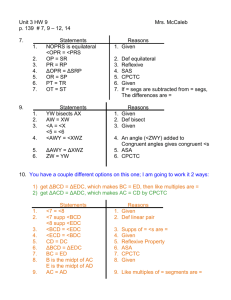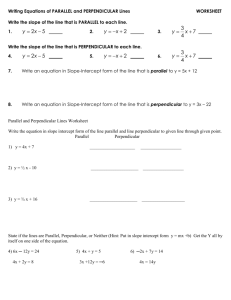Unit 4 HW 13 answers
advertisement
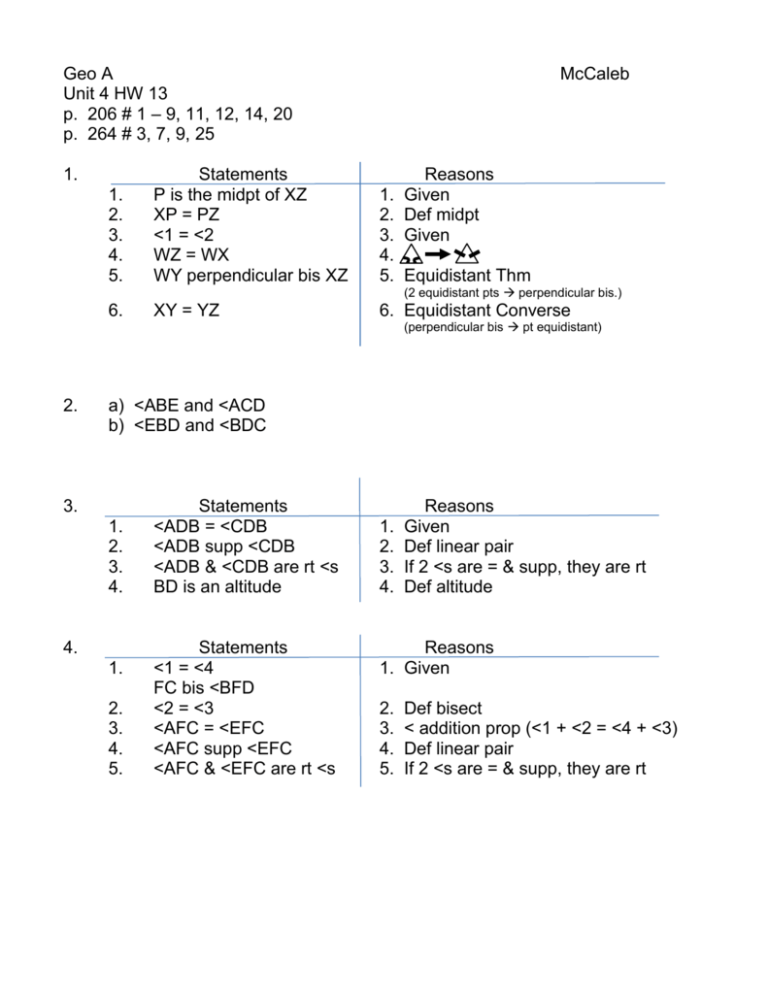
Geo A Unit 4 HW 13 p. 206 # 1 – 9, 11, 12, 14, 20 p. 264 # 3, 7, 9, 25 1. 1. 2. 3. 4. 5. Statements P is the midpt of XZ XP = PZ <1 = <2 WZ = WX WY perpendicular bis XZ McCaleb Reasons 1. Given 2. Def midpt 3. Given 4. 5. Equidistant Thm (2 equidistant pts perpendicular bis.) 6. XY = YZ 6. Equidistant Converse (perpendicular bis pt equidistant) 2. a) <ABE and <ACD b) <EBD and <BDC 3. 1. 2. 3. 4. 4. 1. 2. 3. 4. 5. Statements <ADB = <CDB <ADB supp <CDB <ADB & <CDB are rt <s BD is an altitude Statements <1 = <4 FC bis <BFD <2 = <3 <AFC = <EFC <AFC supp <EFC <AFC & <EFC are rt <s 1. 2. 3. 4. Reasons Given Def linear pair If 2 <s are = & supp, they are rt Def altitude Reasons 1. Given 2. 3. 4. 5. Def bisect < addition prop (<1 + <2 = <4 + <3) Def linear pair If 2 <s are = & supp, they are rt A 5. A D C B D Given: ΔABC is isosceles with base BC ΔDBC is isosceles with base BC Prove: AD is the perpendicular bis of BC 1. 2. 3. C B Statements Reasons ΔABC is isosceles with base BC 1. Given ΔDBC is isosceles with base BC AB = AC 2. Def isosceles DB = DC AD is the perpendicular bis of BC 3. Equidistant Thm (2 equidistant pts perpendicular bis.) 6. 1. 2. 3. 4. Statements ΔABC is isosceles w/ base AC <1 = <2 AB = CB AD = CD BD perpendicular AC Reasons 1. Given 2. Def isosceles 3. 4. Equidistant Thm (2 equidistant pts perpendicular bis.) 7. 1. 2. 3. 4. 5. Statements Circle O M is the midpt of AB MA = MB Draw OA & OB OA = OB OM perpendicular to AB Reasons 1. Given 2. Def midpt 3. 2 pts determine a line 4. All radii of a circle are = 5. Equidistant Thm (2 equidistant pts perpendicular bis.) 8. A P B O C R D Given: Circle O AB = CD P is the midpt of AB R is the midpt of CD Prove: OP = OR 9. a) (midpoint—average!) 𝑦 −𝑦 b) m = 2 1 = 7–1 𝑥2 −𝑥1 c) m = 𝑦2 −𝑦1 𝑥2 −𝑥1 M(9, 4) = 6 15 – 3 = 8–4 = 12 4 11 – 2 9 d) perpendicular to BC, so opp recip e) From (2, 4) to (9, 4) = 9 – 2 = 7 11. 1. 2. 3. 4. 5. Statements Circle O <1 = <2 XY = YW Draw OX & OW OX = OW OY perpendicular to WX =½ no! they are not // b/c they do not have the same slope. -2/1 Reasons 1. Given 2. 3. 2 pts determine a line 4. All radii of a circle are = 5. Equidistant Thm (2 equidistant pts perpendicular bis.) 12. 1. 2. 3. 4. 5. 6. 7. 14. 1. 2. 3. 4. 5. 6. 7. 8. 9. Statements <1 = <2 = <3 = <4 BE = BF BD = BD ΔDBE = ΔDBF <BED = <BFD <BED supp <BEA <BFD supp <BFC <BEA = <BFC ΔABE = ΔCBF Reasons 1. Given Statements <WXY = <ZYX WX = ZY XY = XY ΔWXY = ΔZYX <ZXY = <WYX <WXR = <ZYR <WRX = <ZRY <W = <Z ΔWRX = ΔZRY WR = RZ Reasons 1. Given 2. 3. 4. 5. Reflexive SAS CPCTC Def linear pair 6. Angle subtraction post 7. ASA 2. 3. 4. 5. 6. 7. 8. 9. Reflexive Prop SAS CPCTC < subtraction Prop Vert < thm CPCTC AAS or ASA CPCTC Another option for # 14: 14. 1. 2. 3. 4. 5. 6. 20. 1. 2. 3. 4. 5. 6. 7. 8. 9. Statements <WXY = <ZYX WX = ZY XY = XY ΔWXY = ΔZYX <ZXY = <WYX XR = YR WR = RZ Reasons 1. Given 2. 3. 4. 5. 6. Reflexive Prop SAS CPCTC Segment Subtraction Prop Statements Reasons AB = AF 1. Given BC = FE AE = AC 2. Segment addition prop <A = <A 3. Reflexive ΔACF = ΔAEB 4. SAS <C = <E 5. CPCTC <ABD = <AFD <ABD supp <CBD 6. Def linear pair <AFD supp <EFD <CBD = <EFD 7. Supplements of = <s are = ΔBCD = ΔFED 8. ASA (or you could use the vertical <s and AAS) CD = DE 9. CPCTC p. 264 3. (see p. 216, Thm 30) x + 50 > 3x 50 > 2x 25 > x (or x < 25) 7. a) yes, b/c SSI <s are supp b) no! SSE <s would need to be supp, not congruent c) 120 + x + 40 = 180 x = 20 3x = 3(20) = 60 yes, b/c alt int <s are congruent x + 40 = 60 9. 1. 2. 3. 4. 5. 6. 7. Statements AG = BE AB = CD AC = BD AG // BE <GAB = <EBD ΔGAC = ΔEBD <ACG = <BDE GC // ED 25. 140˚ 50˚ 20˚ 140˚ 40˚ 50˚ 20˚ 20˚ 140˚ 40˚ 30˚ 50˚ 20˚ 20˚ 140˚ 40˚ 30˚ 30˚ 50˚ 20˚ 20˚ x = 40 + 30 = 70˚ Reasons 1. Given 2. 3. 4. 5. 6. 7. Segment addition prop Given // lines corr <s = SAS CPCTC Corr <s = // lines

